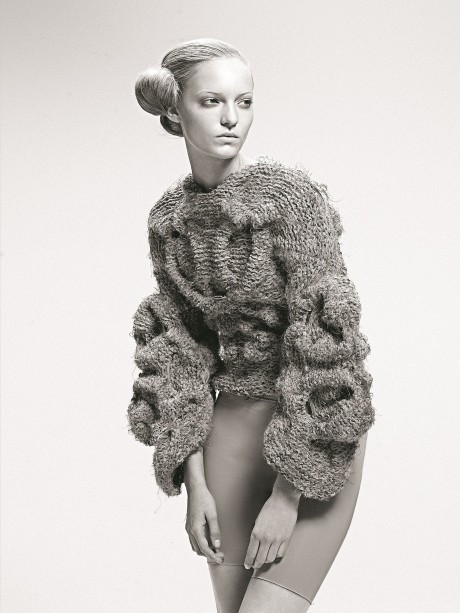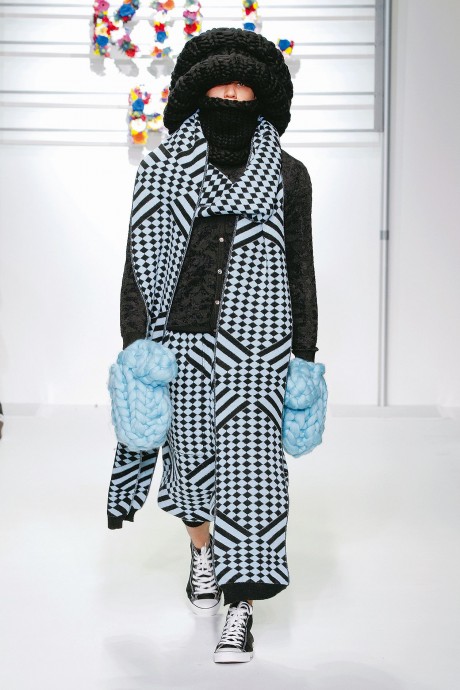Fashion Knitwear is a beautiful book profiling 40 of the hottest contemporary knitwear designers, whose work spans from the desirable to the bizarre! We caught up with author Jenny Udale to find out what she learnt from her time talking to the designers.
How long have you been a textile designer, and what drew you to the industry?
I have been working as a textile designer for over 14 years, producing my own printed fashion line, designing prints for high-end designers like Alexander McQueen and for a textile agent. I love the variety of work and creativity involved. I am drawn to beauty, colour and texture, which I like to explore through my own work.
What was the inspiration behind the Fashion Knitwear project?
I have been a lecturer in textiles (print and knit) for fashion on a variety of Fashion BA and MA degrees. While researching knit for my lecturing I found the work of contemporary knitwear designers very inspirational. I realised there was no book that captured and showcased their amazing work.
Knitwear has been appearing on the catwalks more than ever over the last couple of years. What caused its return to style?
I believe two designers, Sid Bryan from Sibling (who created many catwalk show pieces for fashion designers like McQueen and Giles Deacon) and Sandra Backlund, started a revolution in knitwear. Their handmade sculptural chunky knits were bold and innovative, and influenced a new generation of fashion/ textile students who went on to design their own lines or work in the top fashion companies around the world.

From the Spring/Summer 2011 collection by Sandra Backlund
How did you choose the 40 designers featured in Fashion Knitwear?
I wanted to include a wide variety of designers and companies with a contemporary innovative aesthetic: hand knitters, machine knitters, those using yarn for crochet and macramé, also designers using jersey fabric. I have showcased large companies and also newly graduated designers.
What was the most inspirational thing you took from the designers you interviewed, in terms of your own textile design?
To remain true to your own innovative design ideals, this is what will set you apart from other designers. The challenge is to see how they can be combined with a level of commerciality.
The book includes a lot of discussion about the way in which technology influences knitting and knitwear design. Why do you think that is important?
Technology and craft within textile design and production really interests me. I think it is so important that they are both seen as valid. Many fashion and textile courses are choosing not to teach the fundamental textile principles that include hand-craft techniques, opting instead for digital processes. It is a real loss as students graduate without the basic knowledge of their discipline, also their designs are often less innovative. Quite often design innovation occurs through mistakes and it is harder to make “mistakes” with high-end digital machinery. However, I am not against modern technology – far from it – as it brings so many exciting new possibilities. It is designers with knowledge of the old craft techniques combined with modern technical processes I think are producing the most interesting work.

From the Autumn/Winter 2013 collection by Sibling
What will be the most important trends in knitwear for the next few years?
Traditional craft and yarn, seamless knitting, texture in yarn and stitch. How machine knitting can create texture and craft techniques for larger production, again combining craft and technology. In fashion the trend is for a more minimal sportswear feel, which will be reflected in textiles.
What is the best advice you could give to a budding knitwear designer?
Really experiment with stich, yarn and colour. A simple stitch can create amazing effects when used in a clever way. Create samples and experiment with them on the body, really feel their texture and drape and think how best to use them. Try to start making garments as soon as you can, as it is at this point that the yarn, stitch and proportion really comes together. Finally, the finishes of the garment can be as important as the body of knit.
Fashion Knitwear is published by Laurence King Publishing. Purchase your copy online, or in all good bookstores.






_333_180_c1.png)
_333_180_c1.png)

_333_180_c1.png)
 Baby
Baby
 Toys
Toys
 Garments
Garments
 Crochet
Crochet
 Homewares
Homewares
 Dolls
Dolls



Share